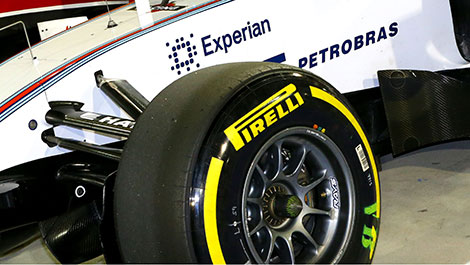May
23rd
Stay connected Subscribe to our RSS feed
The contact patches of the four tires on a car are all that keep it on the road. Formula 1 teams are developing new technologies to improve the performance of Pirelli tires.
Controlling tire temperature, as well as its heating and cooling cycles, is of vital importance to the performance of a modern F1 car.
F1-Monitor's Lawrence Butcher recently wrote that some F1 top teams (including Mercedes AMG) have begun to use a coating on their wheel rims in an attempt to transfer more heat into the tire. This technology is designed to reduce the amount by which they cool on the straights between braking and turning events.
It is thought that the coating in question is a generally available solvent-based product that contains polymers of silicon. The coating is described as a ‘liquid glass', which is normally clear, but adding a black pigment aids heat exchange between the wheel and the tire.
Butcher also explains that the coating also has secondary benefits relating to airflow within the rim, as its very smooth and glossy finish reputedly helps reduce turbulence.
It is not just smooth coatings that are applied to wheels though, and there are a number of heat-resistant coatings available that can be applied with an extremely smooth finish for the same reasons. Another benefit of the high-gloss finish is that it makes the inside of the wheel rim less susceptible to the build-up of debris picked up as a result of brake wear and from the track surface.
The author also pins out that teams also apply a ‘textured' finish on the inner surfaces of their wheels.
The objective of such textured finishes could be to help reduce the boundary layer of air on the inside of the wheel rim as it rotates close to the brake cooling drum, thus helping to reduce drag in much the same way as dimples on a golf ball.
The second objective could also be to offer a greater surface area, which combined with a heat-absorbing coating would further increase heat transfer from the brakes into the tire.
Controlling tire temperature, as well as its heating and cooling cycles, is of vital importance to the performance of a modern F1 car.
F1-Monitor's Lawrence Butcher recently wrote that some F1 top teams (including Mercedes AMG) have begun to use a coating on their wheel rims in an attempt to transfer more heat into the tire. This technology is designed to reduce the amount by which they cool on the straights between braking and turning events.
It is thought that the coating in question is a generally available solvent-based product that contains polymers of silicon. The coating is described as a ‘liquid glass', which is normally clear, but adding a black pigment aids heat exchange between the wheel and the tire.
 |
| Wheel of the Williams F1. (Photo: WRI2) |
Butcher also explains that the coating also has secondary benefits relating to airflow within the rim, as its very smooth and glossy finish reputedly helps reduce turbulence.
It is not just smooth coatings that are applied to wheels though, and there are a number of heat-resistant coatings available that can be applied with an extremely smooth finish for the same reasons. Another benefit of the high-gloss finish is that it makes the inside of the wheel rim less susceptible to the build-up of debris picked up as a result of brake wear and from the track surface.
The author also pins out that teams also apply a ‘textured' finish on the inner surfaces of their wheels.
The objective of such textured finishes could be to help reduce the boundary layer of air on the inside of the wheel rim as it rotates close to the brake cooling drum, thus helping to reduce drag in much the same way as dimples on a golf ball.
The second objective could also be to offer a greater surface area, which combined with a heat-absorbing coating would further increase heat transfer from the brakes into the tire.
 The latest auto news, reviews, prices, product and vehicle releases.
The latest auto news, reviews, prices, product and vehicle releases.